New 1981-2010 Averages being used this year.
Note: This publication is currently undergoing major revisions. The current publication will be replaced with a new publication based on stakeholder requirements and scientific advances. We expect to begin sharing details on this soon. If you have input on content, format, or publication frequency at any time, please contact us at cbrfc.webmasters@noaa.gov.Green Water Supply Outlook, March 1, 2012Green Water Supply Outlook, March 1, 2012
Contents
Green Summary
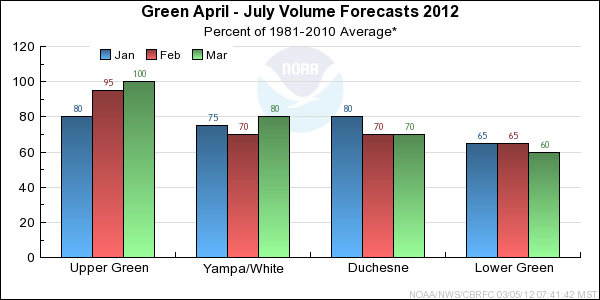
*Median of forecasts within each basin.
Upper Green Basin Conditions
The following conditions influenced this month's forecasts:
Precipitation:
Seasonal October through February
precipitation was 105 percent of average
in the Upper Green basin. February
precipitation was 110 percent of average.
Snow:
March 1st snow water equivalent was 105 percent of average in the basin.
--- Upper Green basin
snow
water equivalent plot.
Streamflow:
February streamflow was near 110 percent of average.
Soil Moisture:
Modeled
soil
moisture states indicated near average to above average soil moisture conditions
last fall prior to snow accumulation.
Climate Forecasts:
Climate forecasts were not a factor because there is not a strong correlation
between La Nina conditions and winter precipitation in the Upper Green basin.
Forecast Summary:
Seasonal precipitation in the Upper Green remains near average as a result of above average precipitation for
all months except December. Snow water equivalent increased slightly from February 1st but still remains
near average. It is also important to note that fall soil moisture conditions were near to above average.
As a result, current April through July streamflow volume forecasts are similar to Februrary 1st or have increased slightly.
Forecasts now range between 80 and 103 percent of average with a median value of 100 percent.
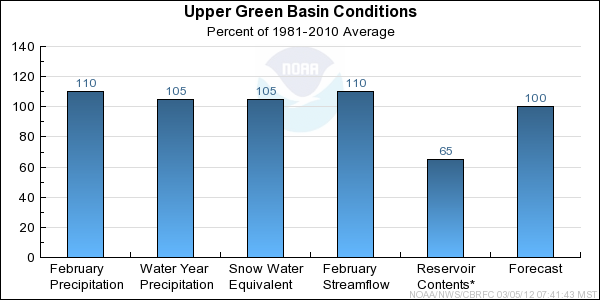
* Percent usable capacity, not percent average contents.
Click for multi-month Graph.
Yampa/White Basin Conditions
The following conditions influenced this month's forecasts:
Precipitation:
Seasonal October through February
precipitation was 80 percent of average
in the Yampa/White basin. February
precipitation was near 120 percent of average.
Snow:
March 1st snow water equivalent was 80 percent of average in the basin.
--- Yampa basin
snow
water equivalent plot.
Streamflow:
February streamflow was near 100 percent of average.
Soil Moisture:
Modeled
soil
moisture states indicated above average to much above average soil moisture conditions
last fall prior to snow accumulation.
Climate Forecasts:
Climate forecasts were not a factor in the forecasts because there is not a strong correlation
between La Nina conditions and winter precipitation in the Yampa/White basin.
Forecast Summary:
February precipitation was above average in the Yampa/White basins. As a result of the above average conditions in February,
both the seasonal precipitation and snow water equivalent have increased from much below average to below average
conditions. It is also important to note that fall soil moisture conditions were
above to much above average. As a result of above average precipitation in February, current April through July streamflow volume
forecasts have increased by 10 to 15 percent and now range between 67 and 83 percent of average with a median value of 77 percent.

* Percent usable capacity, not percent average contents.
Click for multi-month Graph.
Duchesne Basin Conditions
The following conditions influenced this month's forecasts:
Precipitation:
Seasonal October through February
precipitation was 85 percent of average
in the Duchesne basin. February
precipitation was 90 percent of average.
Snow:
March 1st snow water equivalent was 70 percent of average in the basin.
--- Duchesne basin
snow
water equivalent plot.
Streamflow:
Februrary streamflow was 100 percent of average.
Soil Moisture:
Modeled
soil
moisture states indicated much above average soil moisture conditions
last fall prior to snow accumulation.
Climate Forecasts:
Climate forecasts were not a factor in the forecasts because there is not a strong correlation
between La Nina conditions and winter precipitation in the Duchesne basin.
Forecast Summary:
February precipitation was near average in the Duchesne; however,
seasonal precipitation remains below average as a result of much below average and below
average conditions in December and January. Snow water equivalent still remains below average.
However, it is important to note that fall precipitation and soil moisture conditions were
much above average. Wet antecedent conditions are resulting in somewhat higher forecasts for the Whiterocks and Uinta river basins.
As a result, current April through July streamflow volume forecasts remain similar to February 1st or have decreased by 5 to 10
percent and now range between 45 and 93 percent of average with a median value of 70 percent.
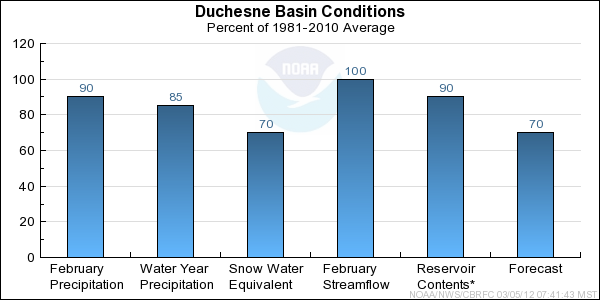
* Percent usable capacity, not percent average contents.
Click for multi-month Graph.
Lower Green Basin Conditions
The following conditions influenced this month's forecasts:
Precipitation:
Seasonal October through February
precipitation was 85 percent of average
in the Lower Green basin. February
precipitation was 100 percent of average.
Snow:
March 1st snow water equivalent was 65 percent of average in the basin.
--- Lower Green basin
snow
water equivalent plot.
Streamflow:
February streamflow was near 110 percent of average.
Soil Moisture:
Modeled
soil
moisture states indicated near average to above average soil moisture conditions
last fall prior to snow accumulation.
Climate Forecasts:
Climate forecasts were not a factor in the forecasts because there is not a strong correlation
between La Nina conditions and winter precipitation in the Lower Green basin.
Forecast Summary:
February precipitation was near average in the Lower Green. However, seasonal precipitation and snow water equivalent remain below average
and much below average in the Lower Green due to below average monthly precipitation in November, December, and January.
It is also important to note the fall soil moisture conditions were near to above average. As a result, current April through July streamflow
volume forecasts remain similar to February 1st or have decreased slightly and range between 56 and 79 percent of average with a median value of 60 percent.
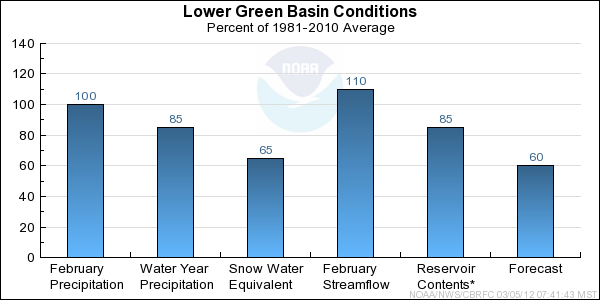
* Percent usable capacity, not percent average contents.
Click for multi-month Graph.
Differences between the full period forecasts and the residual forecasts may not exactly equal the actual observed volumes due to rounding conventions (see Definitions section).
Reservoir Monthly Inflow Forecasts
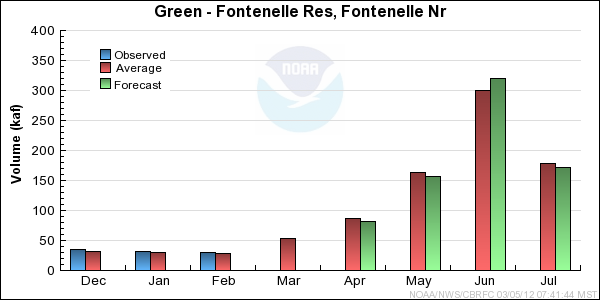
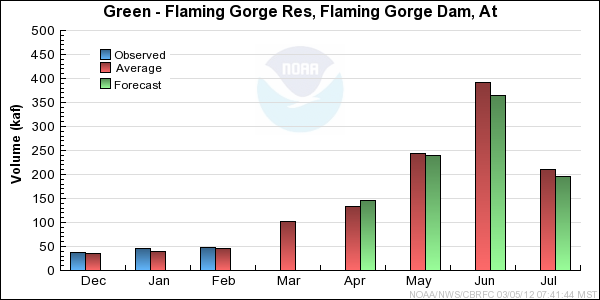
Monthly Streamflows
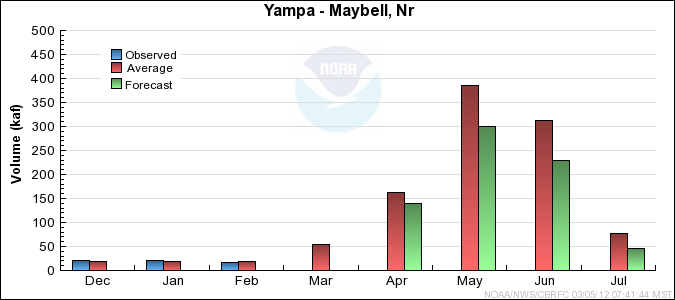
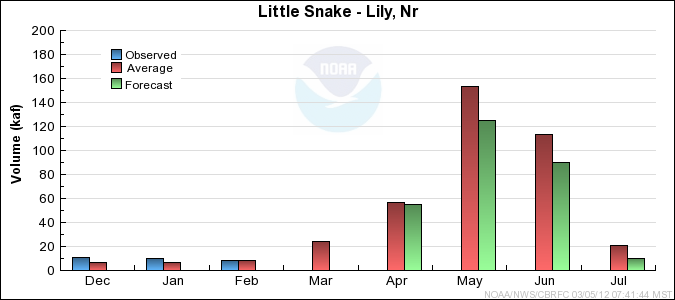
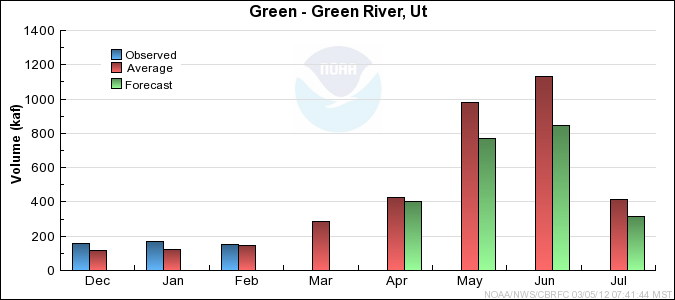
Precipitation Maps
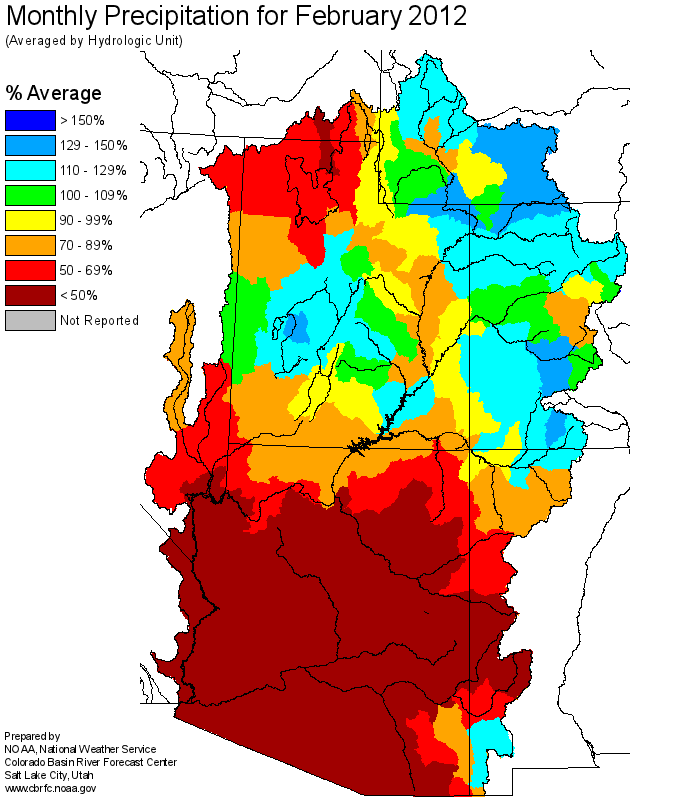
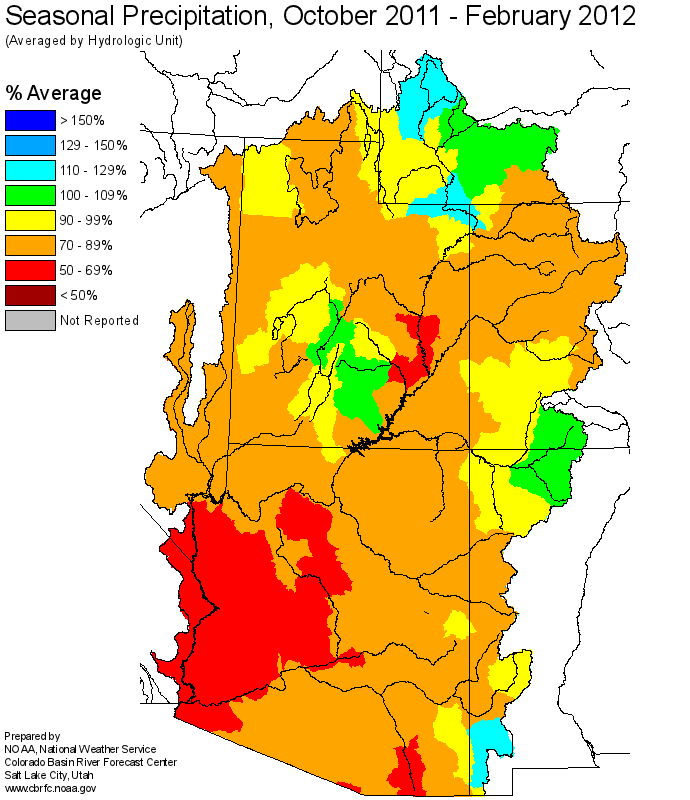
Hydrologist: Ashley Nielson













